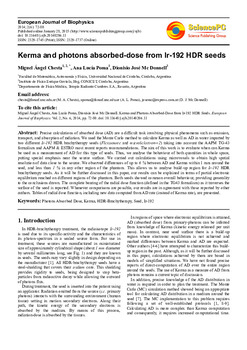| dc.contributor.author | Chesta, Miguel Ángel | |
| dc.contributor.author | Poma, Ana Lucía | |
| dc.contributor.author | Mc Donnell, Dionisio José | |
| dc.date.accessioned | 2022-03-17T12:41:37Z | |
| dc.date.available | 2022-03-17T12:41:37Z | |
| dc.date.issued | 2014 | |
| dc.identifier.citation | Chesta, M. Á., Poma, A. L. y Mc Donnell, D. J. (2014). Kerma and photons absorbed-dose from Ir-192 HDR seeds. European Journal of Biophysics, 2 (6), 72-80. http://dx.doi.org/10.11648/j.ejb.20140206.11 | es |
| dc.identifier.uri | http://hdl.handle.net/11086/23290 | |
| dc.identifier.uri | http://dx.doi.org/10.11648/j.ejb.20140206.11 | |
| dc.description.abstract | Precise calculations of absorbed dose (AD) are a difficult task involving physical phenomena such as emission, transport, and absorption of radiation. We used the Monte Carlo method to calculate Kerma as well as AD in water imparted by two different Ir-192 HDR brachytherapy seeds (Flexisource and microSelectron-v2) taking into account the AAPM TG-43 formalism and AAPM & ESTRO most recent reports recommendations. The aim of this work is to evaluate when can Kerma be used as a measurement of AD for this type of seeds. Thus, we analyse the behaviour of both quantities in whole space, putting special emphasis near the source surface. We carried out calculations using microvoxels to obtain high spatial resolution of data close to the source. We observed differences of up to 6 % between AD and Kerma within 1 mm around the seed, and less than 1 % in any other region of the phantom. This allows us to analyse build-up region for Ir-192 HDR brachytherapy seeds. As it will be further discussed in this paper, our results can be explained in terms of partial electronic equilibrium reached on different regions of the phantom. Both seeds showed common overall behaviour, providing generality to the conclusions drawn. The complete bearing of the radial dose function (defined in the TG43 formalism) as it traverses the surface of the seed is reported. Whenever comparisons are possible, our results are in agreement with those reported by other authors. Tables of radial dose function, including new data computed from AD rate (instead of Kerma rate), are presented. | en |
| dc.description.uri | http://www.sciencepublishinggroup.com/journal/archive.aspx?journalid=117&issueid=1170206 | |
| dc.format.medium | Impreso; Electrónico y/o Digital | |
| dc.language.iso | eng | es |
| dc.rights | Atribución 4.0 Internacional | * |
| dc.rights.uri | http://creativecommons.org/licenses/by/4.0/ | * |
| dc.source | eISSN 2329-1737 | |
| dc.subject | Photons absorbed dose | en |
| dc.subject | Kerma | en |
| dc.subject | HDR-Brachytherapy | en |
| dc.subject | Seed | en |
| dc.subject | Ir-192 | en |
| dc.title | Kerma and photons absorbed-dose from Ir-192 HDR seeds | en |
| dc.type | article | es |
| dc.description.version | publishedVersion | es |
| dc.description.fil | Fil: Chesta, Miguel Ángel. Universidad Nacional de Córdoba. Facultad de Matemática, Astronomía y Física; Argentina. | es |
| dc.description.fil | Fil: Chesta, Miguel Ángel. Consejo Nacional de Investigaciones Científicas y Técnicas. Instituto de Física Enrique Gaviola; Argentina. | es |
| dc.description.fil | Fil: Poma, Ana Lucía. Universidad Nacional de Córdoba. Facultad de Matemática, Astronomía y Física; Argentina. | es |
| dc.description.fil | Fil: Mc Donnell, Dionisio José. Terapia Radiante Cumbres. Departamento de Física Médica; Argentina. | es |
| dc.journal.city | Nueva York | es |
| dc.journal.country | Estados Unidos | es |
| dc.journal.editorial | SciencePG | es |
| dc.journal.number | 6 | es |
| dc.journal.pagination | 72-80 | es |
| dc.journal.referato | Con referato | |
| dc.journal.title | European Journal of Biophysics | en |
| dc.journal.volume | 2 | es |
| dc.description.field | Física Atómica, Molecular y Química (física de átomos y moléculas incluyendo colisión, interacción con radiación, resonancia magnética, Moessbauer Efecto.) | |





